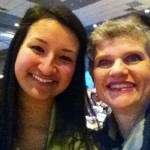 In your life, there are individuals who know you, care about you and want you to succeed. These admirers are your advocates, people who speak on your behalf, not because you ask them to but because they believe in you and want you to succeed. They are the ones who tell other people how gifted or talented you are, how you would be perfect for a job or position or would be a great addition to a board of directors. Many of my advocates are responsible for my career success. Because of them, I was recommended for – and landed – several jobs and board positions.
In your life, there are individuals who know you, care about you and want you to succeed. These admirers are your advocates, people who speak on your behalf, not because you ask them to but because they believe in you and want you to succeed. They are the ones who tell other people how gifted or talented you are, how you would be perfect for a job or position or would be a great addition to a board of directors. Many of my advocates are responsible for my career success. Because of them, I was recommended for – and landed – several jobs and board positions.
Years ago, I received a call from a professional woman who was also my mentor. She had been at dinner the evening before with a man who was looking for a marketing director and company spokesperson. When he asked if she knew anyone who was qualified for the job, she immediately said, “I know the perfect person.” The next day the man who would later become my boss called me, and I ended up working six years for that company. I didn’t ask my mentor to help me find a job. She recommended me because she believed in me and wanted to see me succeed. You see, my mentor had seen me in action, and was familiar with my work style and the quality of my work.
A young woman who I have watched grow in her career for more than 20 years shared her story with me. When I first met her, she was just 18 and had accepted a position with a nonprofit organization as an administrative assistant. She was working her way through college. She had a positive attitude and engaging personality and loved working with people. Several years later, she left that position to work in the Human Resources Department of a large corporation. She had found her career passion.
Early on, she shared with her boss a future goal: To become head of the department. He told her what she would have to do, and said that it would require obtaining experience at one of their out of state plants before moving up within corporate headquarters. When such a position became available, she was the first person he approached. She accepted the position and happily worked her way up through the corporate ranks. It didn’t happen by accident, of course. This boss of hers was her advocate. He believed in her and wanted her to succeed. When the position became available, he knew the “perfect person.”
As you move through your life and career, identify who your greatest advocates are. Keep in contact with them so when greater opportunities become available, they will think of you. Let your intentions become known. You just might receive a call, text or email from your advocate who thought you were that perfect person.
What are you doing to keep in contact with your greatest advocates on a regular basis? How are you letting your intentions become known?





